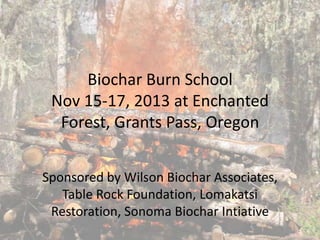Biochar burn school results
- 1. Biochar Burn School Nov 15-17, 2013 at Enchanted Forest, Grants Pass, Oregon Sponsored by Wilson Biochar Associates, Table Rock Foundation, Lomakatsi Restoration, Sonoma Biochar Intiative
- 2. Current Practice: Pile and Burn Cost: $2,000/acre to cut, pile and burn Return: waste treatment â fuel load reduction Byproducts: smoke, sterilized soil, ash, small amounts of char
- 3. Objectives âĒ We can do better! âĒ Try different methods of pile construction and lighting to see if we can produce less smoke and more charcoal to minimize environmental impact of open burns âĒ Keep labor requirements in mind and minimize effort and resources
- 4. Ethics âĒ Open burning is NOT a biochar production method âĒ Volume biochar production methods should produce zero or near zero emissions with capture of useful energy to substitute for fossil fuels âĒ Biochar burning methods are intended as a best practice for situations where open burning is the only practical disposal method of problem biomass
- 5. Physics of Top Lit Burning Wood does not burn directly, rather, heated wood emits gases that burn: âĒ Heat transfers by radiation into the wood âĒ Heated wood releases gases that rise âĒ When hot gases rise they are exposed to air and they burn âĒ Heat converts remaining wood to charcoal âĒ Charcoal will not burn if it is protected from oxygen by the gas flare âĒ If rising gases cool too fast or do not get enough air, smoke results
- 6. Diagram by Tom Reed, www.thomasreedinventions.c om
- 7. Standard burn pile of fir and pine from oak savannah restoration project. Only change is, we light on the top instead of on the bottom.
- 8. TYPICAL BOTTOM LIT BURN PILE
- 9. TOP LIT BURN PILE - CONSUMES SMOKE
- 10. Wood moisture levels ranged from 12% to 30%
- 11. We rebuilt some piles to get a more pyramidal shape with bigger logs on the bottom, and few fine materials
- 13. These piles could be quenched with 2 bladder bags of water. Spread out the char to cool rapidly, reducing water requirement.
- 14. Charcoal yield approximately 40 gallons
- 15. Day 3 Ultimate Pile â culmination of lessons learned: Rule #1: bigger material on bottom, smaller on top.
- 16. Rule #2: Light on the top. If using accelerant, spray a mist evenly across the top. Avoid drip torches that will produce flame underneath unburned material.
- 17. Rule #3: space between sticks roughly equal to stick diameter
- 18. Rule #4. As pile burns down, consolidate fuel for minimum smoke and maximum biochar production. Observe the stick in the air, cooling and smoking.
- 19. Rule #5. Spread out and quench with light mist to conserve water.
- 20. Special Thanks! âĒ Jan and Brenda Patton, owners of Enchanted Forest âĒ Peter Hirst of New England Biochar for expert instruction âĒ All the participants who labored over three days to learn and refine these techniques âĒ Our co-sponsors: Lomakatsi Restoration Project, Table Rock Foundation, Sonoma Biochar initiative âĒ Forest Service soil scientist Jim Archuleta for his preliminary experiments Wilson Biochar Associates specializes in biochar technology and market development. We provide strategic advice and services to businesses and organizations. Kelpie Wilson Wilson Biochar Associates Mobile: 541-218-9890 kelpiew@gmail.com www.wilsonbiochar.com




















